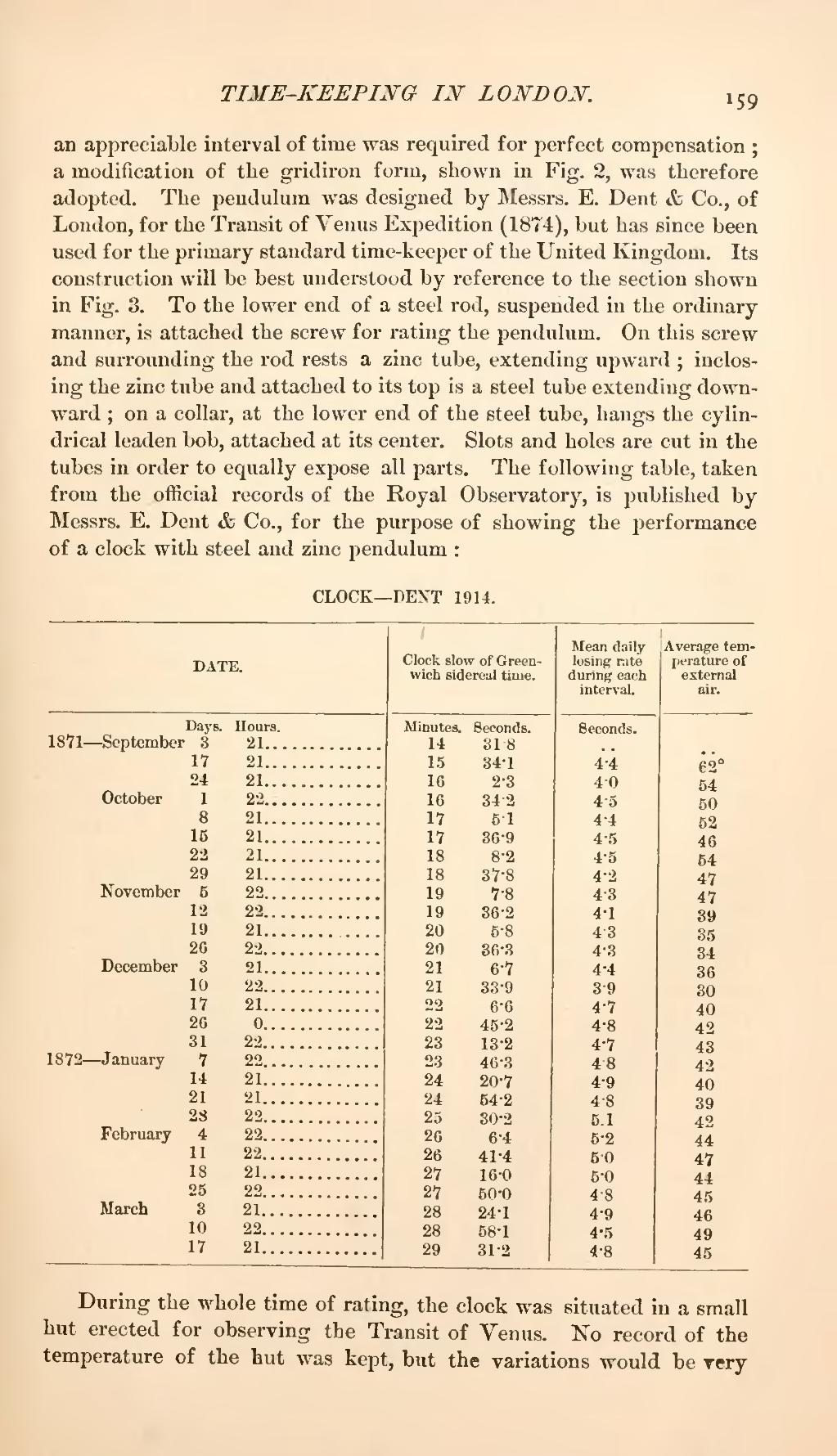an appreciable interval of time was required for perfect compensation; a modification of the gridiron form, shown in Fig. 2, was therefore adopted. The pendulum was designed by Messrs. E. Dent & Co., of London, for the Transit of Venus Expedition (1874), but has since been used for the primary standard time-keeper of the United Kingdom. Its construction will be best understood by reference to the section shown in Fig. 3. To the lower end of a steel rod, suspended in the ordinary manner, is attached the screw for rating the pendulum. On this screw and surrounding the rod rests a zinc tube, extending upward; inclosing the zinc tube and attached to its top is a steel tube extending downward; on a collar, at the lower end of the steel tube, hangs the cylindrical leaden bob, attached at its center. Slots and holes are cut in the tubes in order to equally expose all parts. The following table, taken from the official records of the Royal Observatory, is published by Messrs. E. Dent & Co., for the purpose of showing the performance of a clock with steel and zinc pendulum:
CLOCK—DENT 1914.
| DATE | Clock slow of Green- wich sidereal time. |
Mean daily- losing rate during each interval. |
Average tem- perature of external air. | ||||||
| Days.Hours. | Minutes.Seconds. | Seconds. | |||||||
| 1871—September | 3 | 21 | 14 | 31·8 | . . | . . | |||
| 17 | 21 | 15 | 34·1 | 4·4 | 62° | ||||
| 34 | 21 | 16 | 2·3 | 4·0 | 54 | ||||
| October | 1 | 22 | 16 | 34·2 | 4·5 | 50 | |||
| 8 | 21 | 17 | 5·1 | 4·4 | 52 | ||||
| 15 | 21 | 17 | 36·9 | 4·5 | 46 | ||||
| 22 | 21 | 18 | 8·2 | 4·5 | 54 | ||||
| 29 | 21 | 18 | 37·8 | 4·2 | 47 | ||||
| November | 5 | 22 | 19 | 7·8 | 4·3 | 47 | |||
| 12 | 22 | 19 | 36·2 | 4·1 | 39 | ||||
| 19 | 21 | 20 | 5·8 | 4·3 | 35 | ||||
| 26 | 22 | 20 | 36·3 | 4·3 | 34 | ||||
| December | 3 | 21 | 21 | 6·7 | 4·4 | 36 | |||
| 10 | 22 | 21 | 33·9 | 3·9 | 30 | ||||
| 17 | 21 | 22 | 6·6 | 4·7 | 40 | ||||
| 26 | 0 | 22 | 45·2 | 4·8 | 42 | ||||
| 31 | 22 | 23 | 46·3 | 4·8 | 42 | ||||
| 1872—January | 7 | 22 | 23 | 46·3 | 4·8 | 42 | |||
| 14 | 21 | 24 | 20·7 | 4·9 | 40 | ||||
| 21 | 21 | 24 | 54·2 | 4·8 | 39 | ||||
| 28 | 22 | 25 | 30·2 | 5·1 | 42 | ||||
| February | 4 | 22 | 26 | 6·4 | 5·2 | 44 | |||
| 11 | 22 | 26 | 41·4 | 5·0 | 47 | ||||
| 18 | 21 | 27 | 16·0 | 5·0 | 44 | ||||
| 25 | 22 | 27 | 50·0 | 4·8 | 45 | ||||
| March | 3 | 21 | 28 | 24·1 | 4·9 | 46 | |||
| 10 | 22 | 28 | 58·1 | 4·5 | 49 | ||||
| 17 | 21 | 29 | 31·2 | 4·8 | 45 | ||||
During the whole time of rating, the clock was situated in a small hut erected for observing the Transit of Venus. No record of the temperature of the hut was kept, but the variations would be very

